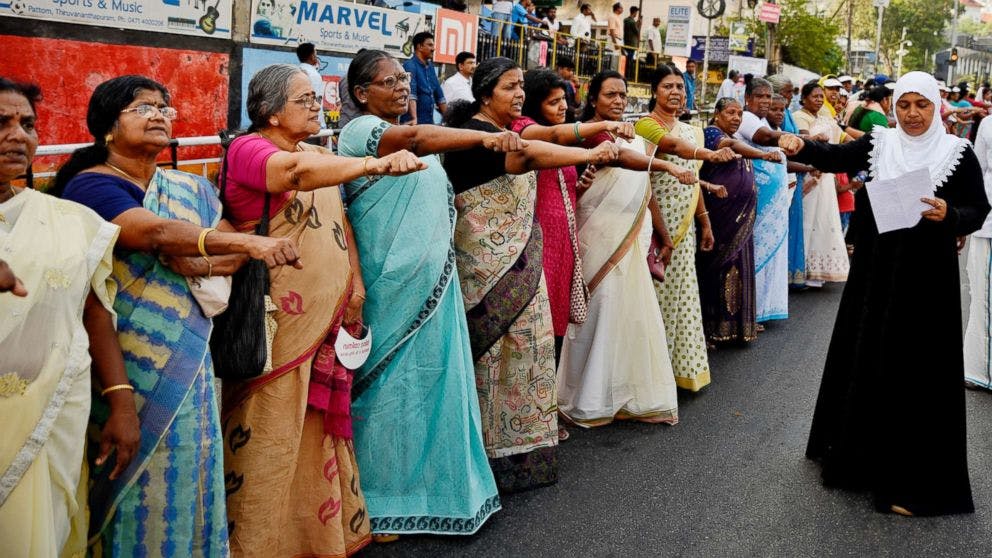While the standoff over a U.S. border wall continues to dominate headlines, there is another wall that deserves primetime coverage: a “Women’s Wall” of unity and equality on the other side of the world.
On New Year’s Day, more than 3 million women banded together to form a ‘Women’s Wall,’ spanning 385 miles along highway 66 in the Indian state of Kerala. It is reportedly the largest public gathering for gender equality in India’s history, and the fourth largest human chain ever.
The wall was built in reaction to a religious ban preventing women of menstruating age from entering a sacred Hindu temple because of the so-called “polluting” effect of menstruation – even after the Supreme Court ruled against the ban last September.
But its significance extends far beyond protesting a discriminatory law; it reflects a much larger global dance of progress and regression on women’s rights, with women’s movements and their supporters having to address issues that many of us thought had been resolved. Unfortunately, as momentum for gender equality gains traction, so do the regressive movements that seek to limit girls’ and women’s equal access to places, opportunities, and resources. We see this all over the world.
For example, as we see women take more leadership positions, they often face direct resistance – a report found that 44% of elected female representatives have been threatened in office, including threats of death, rape, beatings, or abductions. And after years of global progress on expanding women’s access to contraception and reproductive health, progress is now rolling back. The Trump administration’s expansion of the Global Gag Rule and defunding of the UN Population Fund (UNFPA) – which reaches the world’s most vulnerable women in refugee camps and conflict zones – directly threaten women and their families. Even here in the U.S., as we approach the 100th anniversary of women’s right to vote next year, research shows it may take until 2059 to finally reach pay parity in the workforce.
The backlash to progress is real, and that’s why what’s happening in Kerala matters: It symbolizes the necessity of collaborative action. Gender equality is not the mandate of grassroots women’s organizations alone – it should be everyone’s business, like it was in Kerala. More than 176 different social and political organizations, women of all ages and classes from across the state, and the Kerala state government joined together to stand up for women’s equality. Notably, men formed an adjacent wall across from the women to show their solidarity and provided support so women could participate.
The Sustainable Development Goal for Gender Equality (SDG5), adopted unanimously by 193 countries at the United Nations in 2015, recognizes that we need convergence across issues and people to tackle the many root causes of gender discrimination – from cultural norms surrounding child marriage to unfair laws barring women’s political participation. This can only be achieved when all of society steps up – government, civil society, the private sector, communities, women, and men.
Without efforts on every front, in every sector, and at every stage of a woman’s life, no progress is secure. If a girl has equal access to education at age 7, but it is forced into marriage at age 14, her opportunities for equality diminish. If a woman has potential to pursue a meaningful career, but she faces domestic violence at home, her opportunities for equality diminish.
The state of Kerala has the highest women’s literacy rates in India, near equal enrollment rates among girls and boys in school, and the lowest maternal death rates in India. Its investments in girls and women empowered them to further secure their rights and equality in other areas of life. When regressive forces challenge progressive gains, these women are well-prepared to act.
Beyond Kerala we see other encouraging examples of how collaborative action can multiply opportunities for equality. In five countries in Latin America, the UN and EU’s joint Spotlight Initiative is taking a multi-pronged approach to end femicide – the intentional murder of women – by filling policy gaps, collecting better data, and changing harmful attitudes around violence against women. In Rwanda, the government has struck a deal with Catholic Church-run health clinics, which have long opposed contraception, to provide women with options for access. At the 3D Program for Girls and Women, we help local governments work more efficiently across departments to better deliver services for girls and women. In Pune City, India, we help strengthen the livelihoods and safety of vulnerable women who work as recycling and garbage collectors by bringing together women’s cooperatives, trade unions, citizen groups, local government, and the private sector.
At the global level, the historic women’s wall offers valuable lessons for shared action. These are the kinds of walls we should build – strong women, supported by government, their partners, and their children, speaking up for their equal freedoms and progress for all.
Photo Credit: R.S. Iyer/AP

